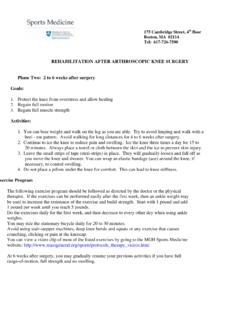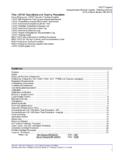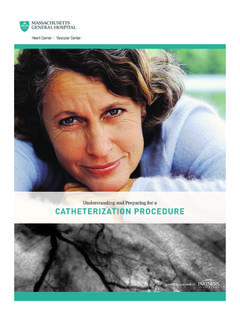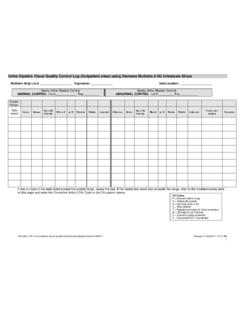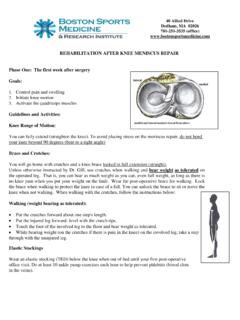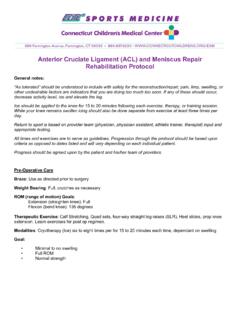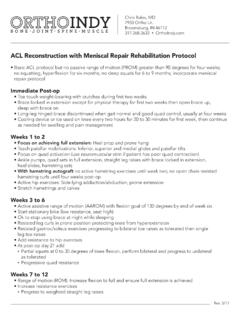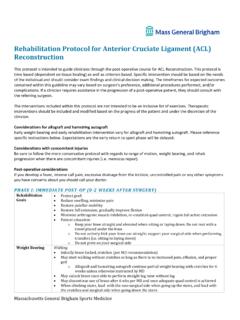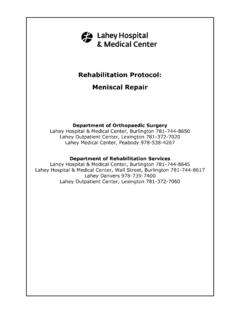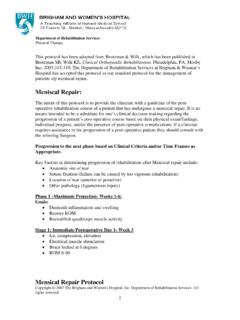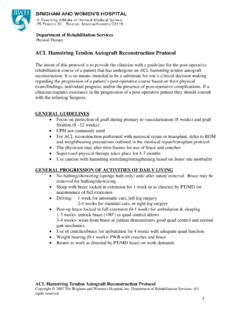Transcription of Rehabilitation Protocol for Arthroscopic Meniscal Repair
1 Mas s a ch u s etts G en era l Br ig h am S p o rts Me d icin e 1 Rehabilitation Protocol for Arthroscopic Meniscal Repair This Protocol is intended to guide clinicians through the post-operative course for Meniscal Repair . This Protocol is time based (dependent on tissue healing) as well as criterion based. Specific intervention should be based on the needs of the individual and should consider exam findings and clinical decision making. The timeframes for expected outcomes contained within this guideline may vary based on surgeon s preference, additional procedures performed, and/or complications. If a clinician requires assistance in the progression of a post-operative patient, they should consult with the referring surgeon. The interventions included within this Protocol are not intended to be an inclusive list of exercises.
2 Therapeutic interventions should be included and modified based on the progress of the patient and under the discretion of the clinician. Considerations for the Post-operative Meniscal Repair Many different factors influence the post-operative Meniscal Repair Rehabilitation outcomes, including type and location of the Meniscal tear and Repair . Consider taking a more conservative approach to range of motion, weight bearing, and rehab progression with more complex tears or all-inside Meniscal repairs. Additionally, this Protocol does not apply to meniscus root repairs or meniscus transplants. It is recommended that clinicians collaborate closely with the referring physician regarding intra-operative findings and satisfaction with the strength of the Repair . Post-operative considerations If you develop a fever, intense calf pain, excessive drainage from the incision, uncontrolled pain or any other symptoms you have concerns about you should call your doctor.
3 PHASE I: IMMEDIATE POST-OP (0-3 WEEKS after SURGERY) Rehabilitation Goals Protect Repair Reduce swelling, minimize pain Restore patellar mobility Restore full extension Flexion < 90 degrees Minimize arthrogenic muscle inhibition, re-establish quad control, regain full active extension Patient education Keep your knee straight and elevated when sitting or lying down. Do not rest with a towel placed under the knee . Do not actively bend your knee ; support your surgical side when performing transfers ( sitting to laying down) Do not pivot on your surgical side. Weight Bearing Walking Brace locked, crutches Partial weight bearing When going up the stairs, make sure you are leading with the non-surgical side, when going down the stairs, make sure you are leading with the crutches and surgical side.
4 Mas s a ch u s etts G en era l Br ig h am S p o rts Me d icin e Interventions Swelling Management Ice, compression, elevation (check with MD re: cold therapy) Retrograde massage Ankle pumps Range of motion/Mobility Patellar mobilizations: superior/inferior and medial/lateral Seated assisted knee flexion extension and heel slides with towel o **Avoid active knee flexion to prevent hamstring strain on the posteromedial joint Low intensity, long duration extension stretches: prone hang, heel prop Seated hamstring stretch Strengthening Quad sets NMES high intensity (2500 Hz, 75 bursts) supine knee extended 10 sec/50 sec, 10 contractions, 2x/week during sessions use of clinical stimulator during session, consider home units distributed immediate post op Straight leg raise o **Do not perform straight leg raise if you have a knee extension lag Hip abduction: side lying or standing Multi-angle isometrics 90 and 60 deg knee extension Criteria to Progress knee extension ROM 0 deg knee flexion ROM 90 degrees Quad contraction with superior patella glide and full active extension Able to perform straight leg raise without lag PHASE II.
5 INTERMEDIATE POST-OP (3-6 WEEKS after SURGERY) Rehabilitation Goals Continue to protect Repair Reduce pain, minimize swelling Maintain full extension Flexion < 90 degrees unless further direction from MD Weight Bearing Walking Continue partial weight bearing unless directed otherwise by MD Consult with referring MD regarding unlocking brace Additional Interventions *Continue with Phase I interventions Range of motion/Mobility Stationary bicycle: gentle range of motion only (see Phase III for conditioning) Cardio Upper body ergometer Strengthening Calf raises Lumbopelvic strengthening: Sidelying hip external rotation clamshell in neutral, plank, bridge with feet elevated Balance/proprioception Double limb standing balance utilizing uneven surface (wobble board) Joint position re-training Criteria to Progress No swelling (Modified Stroke Test) Flexion ROM 120 degrees Extension ROM equal to contra lateral side PHASE III: LATE POST-OP (6-9 WEEKS after SURGERY) Rehabilitation Goals Continue to protect Repair Maintain full extension Mas s a ch u s etts G en era l Br ig h am S p o rts Me d icin e Normalize gait.
6 Flexion within 10 degrees of contra lateral side. Safely progress strengthening. Promote proper movement patterns. Avoid post exercise pain/swelling. Weight Bearing May discontinue use of brace/crutches after 6 weeks per MD and once adequate quad control is achieved and gait in normalized. Additional Interventions *Continue with Phase I-II Interventions as indicated Range of motion/Mobility Supine active hamstring stretch Gentle stretching all muscle groups: prone quad stretch, standing quad stretch, kneeling hip flexor stretch, standing gastroc stretch and soleus stretch Rotational tibial mobilizations if limited ROM Cardio Stationary bicycle, flutter kick swimming, pool jogging Strengthening Partial squat exercise 0-60 degrees Ball squats, wall slides, mini squats from 0-60 deg Hamstring strengthening: prone hamstring curls, standing hamstring curls Lumbopelvic strengthening: bridges on physioball, bridge on physioball with roll-in, bridge on physioball alternating, hip hike Gym equipment.
7 Leg press machine, standing hip abductor and adductor machine, hip extension machine, roman chair, seated calf machine Progress intensity (strength) and duration (endurance) of exercises Balance/proprioception Single limb balance progress to uneven surface including perturbation training Criteria to Progress No swelling/pain after exercise Normal gait ROM equal to contra lateral side Joint position sense symmetrical (<5 degree margin of error) PHASE IV: TRANSITIONAL (9-12 WEEKS after SURGERY) Rehabilitation Goals Maintain full ROM. Safely progress strengthening. Promote proper movement patterns. Avoid post exercise pain/swelling. Additional Interventions *Continue with Phase I-III interventions as indicated Cardio Elliptical, stair climber Strengthening o **The following exercises to focus on proper control with emphasis on good proximal stability Squat to chair Lateral lunges Single leg progression: partial weight bearing single leg press, slide board lunges: retro and lateral, step ups and step ups with march, lateral step-ups, step downs, single leg squats, single leg wall slides knee Exercises for additional exercises and descriptions Gym equipment.
8 Seated hamstring curl machine and hamstring curl machine Romanian deadlift Criteria to Progress No episodes of instability 10 repetitions single leg squat proper form through at least 60 deg knee flexion KOOS-sports questionnaire >70% Mas s a ch u s etts G en era l Br ig h am S p o rts Me d icin e Functional Assessment o Quadriceps index 80%; HHD mean preferred (isokinetic testing if available) o Hamstring, glut med, glut max index 80%; HHD mean preferred (isokinetic testing for HS if available) PHASE V: EARLY RETURN TO SPORT (3-5 MONTHS after SURGERY) Rehabilitation Goals Safely progress strengthening. Safely initiate sport specific training program. Promote proper movement patterns. Avoid post exercise pain/swelling. Additional Interventions *Continue with Phase II-IV interventions as indicated Interval running program o Return to Running Program Progress to plyometric and agility program (with functional brace if prescribed).
9 O Agility and Plyometric Program Criteria to Progress Clearance from MD and ALL milestone criteria below have been met Completion of jog/run program without pain/swelling Functional Assessment o Quad/HS/glut index 90%; HHD mean preferred (isokinetic testing if available) o Hamstring/Quad ratio 70% with isokinetic testing if available) o Hop Testing 90% compared to contra lateral side KOOS-sports questionnaire >90% International knee Committee Subjective knee Evaluation >93 Psych Readiness to Return to Sport (PRRS) PHASE VI: UNRESTRICTED RETURN TO SPORT (6+ MONTHS after SURGERY) Rehabilitation Goals Continue strengthening and proprioceptive exercises. Symmetrical performance with sport specific drills. Safely progress to full sport.
10 Additional Interventions *Continue with Phase II-V interventions as indicated Multi-plane sport specific plyometrics program Multi-plane sport specific agility program Include hard cutting and pivoting depending on the individuals goals Non-contact practice Full practice Full play Criteria to Discharge Quad/HS/glut index 90%; HHD mean preferred (isokinetic testing if available) Hop Testing 90% compared to contra lateral side Revised 4/2021 Contact Please email with questions specific to this Protocol References: 1. Adams D, Logerstedt D, et al. Current Concepts for Anterior Cruciate Ligament Reconstruction: A Criterion-Based Rehabilitation Progression. JOSPT 2012 42(7): 601-614. 2. DeFroda SF, Bokshan SL, et al. Variability of online available physical therapy protocols from academic orthopedic surgery programs for Arthroscopic meniscus Repair .



